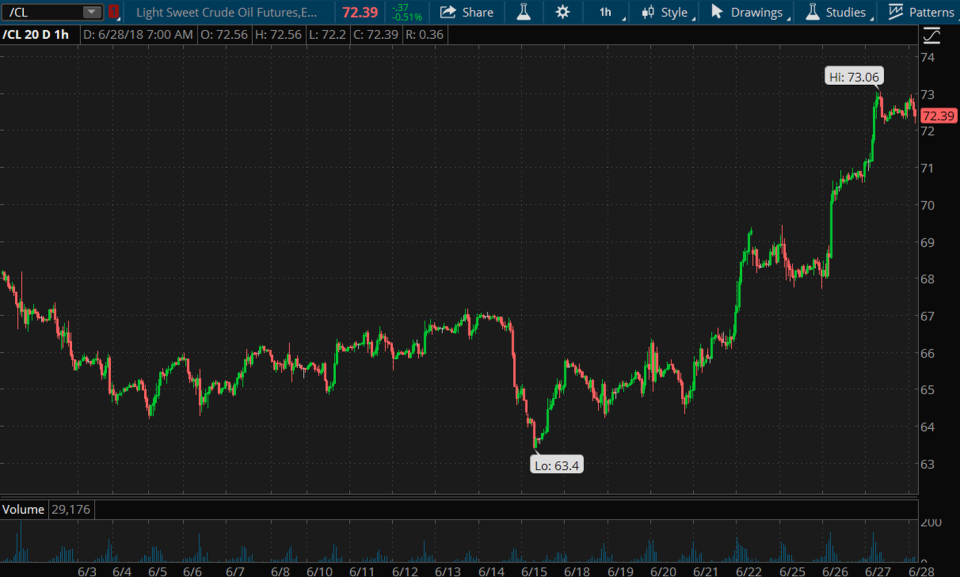Wall Street Remains In Shadow of Trade Uncertainty; Dollar, Crude Gain
An uncertain picture on U.S. business dealings with China appears to be throwing a shadow over Wall Street, but rising oil prices seem to have given a shot in the arm to the energy sector. Meanwhile, the dollar has been ticking higher over the past several months, potentially adding more headwinds as we navigate what's seen by many as a choppy market.
Digesting Restaurant News
In corporate news, Chipotle Mexican Grill, Inc. (NYSE: CMG) shares were down about 4.5% in pre-market trading after the restaurant chain said Wednesday it would close up to 65 underperforming restaurants and make other changes. It remains to be seen how the changes might affect profitability, and Wall Street doesn’t seem too enthusiastic at the moment. The burrito maker is expected to report its quarterly earnings on July 26.
Shares of Walgreens Boots Alliance Inc. (NYSE: WBA) were also lower by around 9% in pre-market trading. Reports of Amazon.com, Inc. (NASDAQ: AMZN) purchasing online pharmacy PillPack and WBA reporting lower international and domestic comparable store sales helped to push the stock lower despite stronger-than-expected earnings.
If the dollar continues to notch gains, firms with strong international sales units could feel the pinch, as foreign-based revenue translates into fewer dollars. This is something investors might want to keep an eye on through the upcoming earnings season.
Trade Remains In Focus
Stocks declined Wednesday as Wall Street continued to be jittery about foreign investment and international trade.
Investors had appeared relieved as the Trump administration signaled the government will use the Committee on Foreign Investment in the United States (CFIUS), which applies to all countries on a case-by-case basis, to handle issues about foreign-owned companies investing in the U.S. tech sector. Previously, media reports seemed to have gotten Wall Street worried that the administration would specifically target Chinese investment in the sector.
But then National Economic Council Director Larry Kudlow made comments on the Fox Business Network that the market seemed to interpret as saying the United States isn’t softening its stance on foreign investment involving China.
The worries about curbs on Chinese investment in U.S. tech companies come against a backdrop of a tit-for-tat trade dispute between the world’s two largest economies that many investors feel may dent global economic growth.
Sector Watch: Tech, Financials Lower; Energy a Bright Spot
Information technology led the S&P 500-sector losers Wednesday, followed by consumer discretionary stocks and financials.
Meanwhile, the energy sector was yet again the biggest winner among sectors in the green as oil prices continued their climb (see figure 1 below). U.S. crude closed at its highest point since November 2014 as a large drop in domestic inventories added to supply worries from Canada and Libya even as Washington has said its allies must stop importing from Iran or face sanctions.
Figure 1: Big Month for Crude. After a mid-month break to the low 60s, crude oil futures (/CL) surged 15%, touching $73 yesterday. Data source: CME Group. Chart source: The thinkorswim platform from TD Ameritrade. For illustrative purposes only. Past performance does not guarantee future results.
Oil Producers and Consumers
Rising oil prices are a double-edged sword. On the one hand, they can help boost producing companies and others in the energy sector. On the other hand, they can be a headwind for firms that rely heavily on fuel, such as trucking and airline companies. For transportation companies, it could be interesting to see how rising oil prices affect their outlooks for the rest of the year.
Rotating or Retreating?
Amid worries about global trade, the Russell 2000 (RUT) has been a bit of a haven because it represents domestic, small-cap stocks with less exposure to international markets than, say, the big multinationals housed in the Dow Jones Industrial Average ($DJI). So it’s notable that on Wednesday, the Russell lost more ground percentage-wise than the big three U.S. indices, even though the Dow, S&P 500 (SPX), and Nasdaq Composite (COMP) were under pressure yet again from global trade uncertainty. It echoes what the market did earlier in the week and raises questions about a broader investor retreat. In a sign over the past few weeks that investors perhaps have been dismissive of the trade issues becoming a full-blown trade war, they have been “happy to buy into the more domestically focused small-cap arena than retreat from equities altogether,” as investment research firm CFRA put it. “Yet, on Monday, investors began to take evasive action by lightening up on a variety of sizes, sectors, sub-industries and regions” with U.S. large-, mid- and small-cap equities each falling by more than 1%. The firm is encouraging clients to ride out the choppiness, which typically increases as midterm elections approach.
Consumer Expectations
Consumer confidence has taken a hit, but there could be a silver lining. The Conference Board’s Consumer Confidence Index dropped more than expected to 126.4 in June from an upwardly revised 128.8 the previous month. “The key takeaway from the report is that the downturn was driven by a downshift in the Expectations Index, which suggests, according to the Conference Board, that consumers don't anticipate the economy gaining much momentum in the coming months,” according to Briefing.com. Let’s say economic growth doesn’t pick up steam. Well, the economy overall has been doing pretty well in terms of economic growth. And if growth can continue at a moderate pace, without an acceleration of inflation, that could keep the economy in a Goldilocks pattern of not being too hot or too cold.
Information from TDA is not intended to be investment advice or construed as a recommendation or endorsement of any particular investment or investment strategy, and is for illustrative purposes only. Be sure to understand all risks involved with each strategy, including commission costs, before attempting to place any trade.
See more from Benzinga
© 2018 Benzinga.com. Benzinga does not provide investment advice. All rights reserved.

